|
|
|
Sort Order |
|
|
|
Items / Page
|
|
|
|
|
|
|
| Srl | Item |
| 1 |
ID:
182661
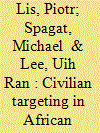

|
|
|
|
|
| Summary/Abstract |
Armed conflict actors frequently target civilian populations. Thus, an improved understanding of such behaviour could pave the way to reducing it. We use the Civilian Targeting Index (CTI) and a broad array of geo-referenced data to investigate the spatio-temporal and economic dynamics of civilian targeting by conflict actors in Africa. Two main insights are generated. First, the civilian targeting behaviour of African non-state conflict actors is strongly influenced by the behaviour of other proximate actors. In particular, non-state actors tend to increase their civilian targeting after nearby non-state actors have done so. Possible mechanisms to explain such spatial spillovers include emulation and retaliation. Second, a negative relationship between economic activity and civilian targeting exists and applies to both state and non-state actors. In addition, CTIs of non-state actors tend to increase with population density, the geographical spread of their conflict activity and conflict duration. State actors have higher average CTIs than non-state actors do, but the gap between the two actor types tends to close during long-duration conflicts.
|
|
|
|
|
|
|
|
|
|
|
|
|
|
|
|
| 2 |
ID:
182669


|
|
|
|
|
| Summary/Abstract |
Authoritarian regimes frequently attempt to justify repression by accusing their opponents of violent behavior. Are such claims successful at persuading the public to accept state-sponsored violence, and can these claims be contested effectively by human rights organizations seeking to publicize evidence contradicting the regime’s narrative? To evaluate these questions, we conducted a survey experiment in Egypt using Facebook advertisements to recruit respondents safely. The experiment evaluates the persuasiveness of competing information provided by a human rights organization and the Egyptian security forces in shaping attitudes toward an incident of state-sponsored violence in which security forces killed several leaders of the opposition Muslim Brotherhood. We find evidence for the ability of Egyptian security forces to increase support for this repression when they control the narrative about why violence was used. However, we also find that the effects of this propaganda disappear when paired with information from Human Rights Watch that counters the security forces’ justifications. These findings provide experimental evidence that propaganda can help authoritarian regimes to increase public support for repression, but they also indicate that human rights organizations can play some role in mitigating this support when they succeed at disseminating countervalent information in these contexts.
|
|
|
|
|
|
|
|
|
|
|
|
|
|
|
|
| 3 |
ID:
182676
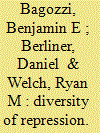

|
|
|
|
|
| Summary/Abstract |
Tactical repertoires of mobilization and repression play an essential role in understanding dynamics of political violence, yet existing quantitative approaches focus primarily on intensities or counts of repressive actions. We focus instead on the diversity of repression, and demonstrate a novel method of measuring repertoires of state repression using event data. We show that more repressive states are likely to employ more diverse repertoires of repression, rather than specializing narrowly in particularly coercive tactics. We demonstrate that, globally, repertoires of state repression are growing less diverse over time. Finally, in the Online appendix, we model repertoires of repression across countries and over time, finding evidence of broader repertoires during protest and civil war, but narrower under democratic regimes and international human rights treaties.
|
|
|
|
|
|
|
|
|
|
|
|
|
|
|
|
| 4 |
ID:
182672
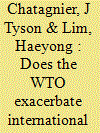

|
|
|
|
|
| Summary/Abstract |
As one component of its mission to reduce trade barriers and encourage the liberalization of international commerce, the World Trade Organization provides states with a forum in which they can raise and resolve complaints about partners’ unfair trading practices. This mechanism streamlines the process of identifying non-compliant behavior, and provides real incentives for the removal of such policies. By furnishing a form of dispute resolution, the institution should be both trade-inducing and peace-enhancing for member states. However, this very mechanism also has the potential to aggravate existing dispute for two reasons. First, it removes the opportunity for states to use economic policies as instruments of structural linkage in resolving disputes. Second, it deprives its members of powerful economic tools that could be used in lieu of militarized responses. Using the implementation of the WTO Dispute Settlement mechanism, as well as the subsequent expiration of Article 13 of the WTO Agreement on Agriculture (the so-called ‘peace clause’), we examine whether the opportunity to resolve trade disputes through the organization affects the likelihood that member states engage in militarized conflict with one another. We find that membership in a trade institution facilitates peaceful interaction, but that judicialization erases these benefits. We conclude that institution building requires caution and attention to the possibility of unintended consequences.
|
|
|
|
|
|
|
|
|
|
|
|
|
|
|
|
| 5 |
ID:
182668


|
|
|
|
|
| Summary/Abstract |
This article posits that free-market institutions and practices reduce economic distortions that provide rents for underground organizations, which ultimately form criminogenic environments. Rents from market distortions provide ‘lootable income’ that feeds ‘criminal organizations’, which rely on violence for enforcement of contracts. Using an index of economic freedom, this study contrasts several relevant measures of political freedoms, political discrimination of individuals and groups, and measures of equal access to state ‘goods’ as proxies for political legitimacy and discrimination on the homicide rate. Fixed effects regression results suggest robustly that economic freedom, not political legitimacy, inclusive politics, or state capacity, reduces the homicide rate, results that are stubbornly significant and substantively large. The basic results are robust to a barrage of model specifications, different sample sizes, and estimation strategies, including instrumental variables analysis. The evidence suggests that unusually high homicide rates might be based in quotidian organizational activities related to ‘illegal’ markets rather than to political grievance-based explanations relating to relative deprivation and political legitimacy. Countries wishing to encourage growth-promoting policies need not fear higher levels of interpersonal violence based on various arguments linking free-market policies to societal disarray.
|
|
|
|
|
|
|
|
|
|
|
|
|
|
|
|
| 6 |
ID:
182670
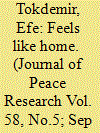

|
|
|
|
|
| Summary/Abstract |
How do people react to foreign actors’ involvement in a conflict in a third party? Many studies have explored how individuals react to their country’s foreign policy choices, as well as how they react to the policies targeting their countries. Yet, we know less about how they form their attitudes regarding the policies not directly aiming at their own countries, and hence, their well-being. Building on intergroup relations and employing a social psychological approach, this article argues that identity serves as a heuristic through which individuals evaluate foreign actors, and their policies targeting in- and out-group members living abroad. Conducting a survey experiment in Turkey, I test my claims in the context of the Syrian Civil War. The findings of the experiments reveal that transnational identity ties have an impact on attitude formation: Turks and Kurds express positive/negative attitudes towards the USA and Russia conditional on whether their involvement to the conflict favor/disfavor their in-group/out-group across the border. Broadly speaking, the results show that domestic cleavages are of importance in predicting the public’s reaction to the developments in international politics, which implies a necessity of taking domestic politics in designing soft power promotion and public diplomacy strategies for many global and regional powers in attempting to win hearts and minds abroad.
|
|
|
|
|
|
|
|
|
|
|
|
|
|
|
|
| 7 |
ID:
182660
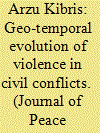

|
|
|
|
|
| Summary/Abstract |
Existing works on diffusion fail to account for the incapacitating effects conflict events may have on the operational capability of the combatant sides and how these effects may determine the evolution of a conflict. I hypothesize that it is those events with losses on the state side that are likely to be associated with geo-temporal spillovers, whereas events with insurgency losses are less likely to be associated with future mayhem in their vicinity. To test my arguments, I first introduce a new, comprehensive and detailed event dataset on the long-running civil conflict in Turkey. The Turkish State–PKK Conflict Event Database (TPCONED) includes the exact date and county-level location for the fatal events of the armed conflict between the Turkish state and the rebel organization PKK since its very beginning in 1984 with detailed information on combatant casualties. I then employ a split population bi-probit model which allows me to comprehensively depict the geotemporal evolution of the conflict by acknowledging, estimating and accounting for the variation in the underlying conflict proneness across locations as a latent variable that shapes the diffusion of events. The results of the statistical analyses offer support for my hypotheses and reveal that how events evolve over space and time is conditioned by the damages suffered by the combatant sides. I demonstrate the robustness of these results on a matched sample I obtain by employing the Coarsened Exact Matching (CEM) on the data.
|
|
|
|
|
|
|
|
|
|
|
|
|
|
|
|
| 8 |
ID:
182662
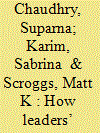

|
|
|
|
|
| Summary/Abstract |
The use of forced recruitment strategies during war can adversely affect military effectiveness and human rights. Given these costs, under what conditions do state leaders adopt coercive recruitment during civil wars? We find that between 1980 and 2009, states changed their recruitment practices 140 times during civil wars – half of which were towards coercive recruitment. Since structuralist explanations focus on factors that remain more or less constant over time, they cannot explain the frequency of these changes. Instead, we focus on individual-level factors and argue that leaders’ dispositions as risk-takers determine their beliefs about using force to solve collective action dilemmas during civil wars. Further, conflict context matters for leaders’ recruitment decisions – when rebel groups engage in coercive recruitment, leaders may also feel more justified in using such strategies. Using the LEAD Dataset and data on recruitment, we find that risk-tolerant leaders, including those who have had careers in the security sector, as well as those who have prior experience as a rebel or revolutionary leader, are more likely to use force to increase recruitment. While we theorize that this effect may be mitigated by combat experience, the evidence is mixed. Lastly, we find that rebels’ use of forced recruitment makes state leaders less likely to use voluntary recruitment.
|
|
|
|
|
|
|
|
|
|
|
|
|
|
|
|
| 9 |
ID:
182673
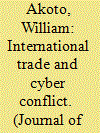

|
|
|
|
|
| Summary/Abstract |
A state’s decision to engage in cyber operations has important implications for its trade. Successful cyber espionage could yield valuable trade secrets that could boost domestic production and spur economic growth. On the other hand, uncovered cyber operations could invite devastating sanctions that retard economic development. In spite of this, the nexus between trade and cyber attacks has received little attention in the literature. In this article, I explore how a state’s trade relations affect its propensity to engage in cyber attacks. I develop a theoretical framework that links the composition of a state’s trade to its deficit in proprietary information relative to other states. I decompose trade into its inter- and intra-industry components and show that while inter-industry trade is associated with higher incidence of state-sponsored cyber attacks, intra-industry trade has the opposite effect. I also show that these effects are non-monotonic, varying by the share of inter- or intra-industry trade in total trade. The results also show that states that have a heavy concentration of high-tech industries such as aerospace, computers, and pharmaceuticals have a higher propensity to engage in cyber espionage operations. These results are robust to a variety of controls and specifications.
|
|
|
|
|
|
|
|
|
|
|
|
|
|
|
|
| 10 |
ID:
182675


|
|
|
|
|
| Summary/Abstract |
The colonization of the Northern Hemisphere between 1500 and 1900 produced nearly 150 separate conflicts between colonial powers and Native American communities. These conflicts have been largely overlooked in studies of international relations, particularly the quantitative tradition of scholarship. This article introduces a new dataset on conflicts involving Native American groups and colonial actors. As a starting point, this article briefly examines how the discipline has approached Native Americans and indigenous peoples. Next, the criteria for a new dataset on Native American Conflict History (NACH) is introduced. The challenges of navigating the historical record are discussed. And finally, a descriptive statistical overview of the data is presented that explores temporal and geographic patterns in the frequency, scale, and duration of conflicts. The article notes different patterns between European state combatants and ‘settler’ state combatants. Notably, the frequency of conflict increases dramatically in both Mexico and the United States during the second half of the 19th century while the scale of conflict remains largely unchanged.
|
|
|
|
|
|
|
|
|
|
|
|
|
|
|
|
| 11 |
ID:
182677


|
|
|
|
|
| Summary/Abstract |
Scholars have used United Nations Secretary-General’s (UNSG) reports to extract information on peacekeeping operations (PKOs). As key peacekeeping political documents, UNSG reports contain much more information on the politics of peacekeeping. Furthermore, manually extracting information is costly and time-consuming. By providing a machine-readable collection of the UN Secretary-General’s Reports on PKOs (1994–2020), the PeaceKeeping Operations Corpus (PKOC) offers highly structured and multiformat text data that connect the peace and conflict research community to recent advancements in text-as-data techniques. Besides paving the way for the first quantitative content analyses on PKOs, PKOC speeds up and expands the range of information analysable from these documents and allows researchers to query them in a quicker, systematic and reproducible way. In this article, we discuss PKOC’s core characteristics. As illustration of the innovative potential of PKOC, we show how text-as-data approaches provide more nuanced understanding on PKOs’ evolution toward multidimensionality, both over time and within missions. While last generation PKOs are assumed to be multidimensional, we show how they vary in multidimensionality and how their complexity also changes throughout their life-cycle.
|
|
|
|
|
|
|
|
|
|
|
|
|
|
|
|
| 12 |
ID:
182663
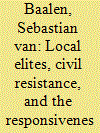

|
|
|
|
|
| Summary/Abstract |
Why is rebel governance more responsive in some areas than in others? In recent years, scholars have started to examine the determinants of rebel governance. Less attention has been given to explaining variation in the responsiveness of rebel governance, that is, the degree to which rebels are soliciting and acting upon civilian preferences in their governance. This article seeks to address this gap by studying local variation in rebel responsiveness. I argue that rebel responsiveness is a function of whether local elites control clientelist networks that allow them to mobilize local citizens. Strong clientelist networks are characterized by local elite control over resources and embeddedness in local authority structures. In turn, such networks shape local elites’ capacity for mobilizing support for, or civil resistance against, the rebels, and hence their bargaining power in negotiations over rebel governance. Drawing on unique interview and archival data collected during eight months of fieldwork, as well as existing survey data, the study tests the argument through a systematic comparison of four areas held by the Forces Nouvelles in Côte d’Ivoire. The analysis indicates that the strength of local elites’ clientelist networks shapes rebel responsiveness. Moreover, it provides support for the theorized civil resistance mechanism, and shows that this mechanism is further enhanced by ethnopolitical ties between civilians and rebels. These findings speak to the burgeoning literature on rebel governance and to research on civil resistance. In addition, the results inform policy debates on how to protect civilians in civil war.
|
|
|
|
|
|
|
|
|
|
|
|
|
|
|
|
| 13 |
ID:
182678


|
|
|
|
|
| Summary/Abstract |
Tasks Assigned to Missions in their Mandates (TAMM) provides comprehensive new data on the mandates of UN missions between 1948 and 2015. Until now, datasets have described mandates in terms of their influential characteristics, such as whether they are robust or multidimensional, or placed them into broad categories driven by idiosyncratic theoretical expectations. Despite limitations on data availability, mandates have been tied to numerous outcomes related to peacekeeping effectiveness. TAMM meets the need for flexible, minimally processed, and fine-grained data on mission mandates by recording the full range of tasks in mandates. The dataset comes in mission-resolution and mission-month versions that are designed to complement existing data on peacekeeping and to be easily adaptable to a wide range of research interests. In this article, I introduce TAMM and use the data to conduct a replication and expansion of Hultman, Kathman and Shannon (2014). I find evidence that missions with mandates that dictate they provide security guarantees and raise the costs of fighting, reduce battlefield hostilities.
|
|
|
|
|
|
|
|
|
|
|
|
|
|
|
|
| 14 |
ID:
182664
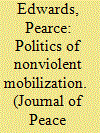

|
|
|
|
|
| Summary/Abstract |
Nonviolent resistance is considered one of the most effective methods of bringing about political change. Yet empirical research on how nonviolent campaigns emerge is limited. This article considers two sets of considerations which influence the strategic decision of a campaign to use nonviolent or violent methods: interactions with the state and campaign resources. Campaigns are concerned about the risk of repression from the state and are more likely to choose nonviolence when they believe the state will accommodate their demands. Open political competition signals likely accommodation. Campaigns’ nonviolent tactics are more effective when they possess social movement resources, though high levels of movement resources threaten the state. The argument implies political competition and social movement resources are associated with a higher likelihood of a campaign using nonviolence, though the relationship with social movement resources diminishes at high levels. Implications of the argument are tested on a sample of contentious campaigns from 1945 to 2006. Political competition and social movement resources are related as expected to the use of nonviolence. However, an extension shows these factors do not account for the advantage of nonviolent methods, particularly in triggering backlash protests, once a campaign is under way. An original ordinal measurement strategy for campaign methods suggests the intensity of violence and nonviolence are likewise unrelated to competition and resources.
|
|
|
|
|
|
|
|
|
|
|
|
|
|
|
|
| 15 |
ID:
182674


|
|
|
|
|
| Summary/Abstract |
This article examines what scholars can learn about civilian killings from newswire data in situations of non-random missingness. It contributes to this understanding by offering a unique view of the data-generation process in the South Sudanese civil war. Drawing on 40 hours of interviews with 32 human rights advocates, humanitarian workers, and journalists who produce ACLED and UCDP-GED’s source data, the article illustrates how non-random missingness leads to biases of inconsistent magnitude and direction. The article finds that newswire data for contexts like South Sudan suffer from a self-fulfilling narrative bias, where journalists select stories and human rights investigators target incidents that conform to international views of what a conflict is about. This is compounded by the way agencies allocate resources to monitor specific locations and types of violence to fit strategic priorities. These biases have two implications: first, in the most volatile conflicts, point estimates about violence using newswire data may be impossible, and most claims of precision may be false; secondly, body counts reveal little if divorced from circumstance. The article presents a challenge to political methodologists by asking whether social scientists can build better cross-national fatality measures given the biases inherent in the data-generation process.
|
|
|
|
|
|
|
|
|
|
|
|
|
|
|
|
| 16 |
ID:
182665


|
|
|
|
|
| Summary/Abstract |
This article builds on the intellectual legacy of Jan Tinbergen by extending his analysis on welfare and security into a framework involving strategic interaction. I first incorporate welfare and security in terms of interstate tensions into a single utility or payoff function. An uncertain world is characterized by states that are more peaceful, and others where nations are more hostile to each other. Both conflictual and peaceful outcomes lie along a spectrum of hostility short of war. The strategies adopted by the two countries, which promote peace, can be complements or substitutes. This means that they can go up or down in response to increases in the strategies of its rival. I demonstrate that non-cooperative behaviour between nations is Pareto inferior to cooperative behaviour, because the latter is associated with more actions and efforts to promote peace. Cooperative behaviour is akin to Tinbergen’s notion of world government. Non-cooperative behaviour by states also leads to moral hazard, and there can be free-riding in joint peaceful behaviour by some nations, particularly when the strategies of the countries are substitutes. The model is extended to aggressive international behaviour, including that mandated by populist plebiscites or election victories, as well as an outline of individual behaviour driven by identity-based politics.
|
|
|
|
|
|
|
|
|
|
|
|
|
|
|
|
| 17 |
ID:
182666
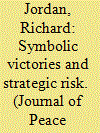

|
|
|
|
|
| Summary/Abstract |
This article studies the rational side of symbolic victories. It opens with the broad question, why are some battles more significant than others? Extending the literature on bargaining and war, it argues that a belligerent can deliberately increase strategic risk in order to communicate its strength. By increasing the information a battle conveys, the belligerent artificially creates the conditions for a symbolic victory. In short, strategic risk becomes a useful, costly signal. This claim is developed in a formal model in which players choose between more and less dangerous military options. Under most conditions, a symbolic equilibrium exists in which both strong- and weak-type players are able to signal their types after only one round. This equilibrium’s rapid information flow is unusual in the rationalist literature: typically, strong types must wait to signal effectively. The article goes on to establish that, when the prior probability a player is strong is sufficiently small, this symbolic equilibrium uniquely satisfies the intuitive criterion. It then applies the model to two famous episodes from military history, the Doolittle Raid of WWII and the battles of Cannae and Capua of the Second Punic War. For both, it highlights how actors deliberately manipulate strategic risk to communicate with adversaries, allies, and their own publics.
|
|
|
|
|
|
|
|
|
|
|
|
|
|
|
|
| 18 |
ID:
182671
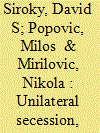

|
|
|
|
|
| Summary/Abstract |
Recognition of aspiring states from established countries is central to becoming a member state of the international system. Previous research suggests that great power recognition decisions regarding aspiring states rapidly converge toward either recognition or non-recognition, yet great power convergence has still not occurred in the case of Kosovo after more than ten years. Unilateral secessions typically remain wholly unrecognized, since they violate the norm of home state consent, yet Kosovo has now been recognized by more than 100 countries. Why do some countries extend recognition to unilateral secessions, and do so early, whereas others delay recognition or withhold it altogether? In the case of Kosovo, great power influence and contestation, rather than convergence, have played a key role in shaping recognition decisions. We argue that countries in the US sphere of influence, with strong economic and military ties, are more likely to recognize Kosovo and to do so relatively fast, whereas countries influenced by Russia are less likely to recognize Kosovo at all, or to do so only after an extended delay. However, great powers are not equal in influencing other states to adopt their preferred position, since the USA is more powerful than Russia and can benefit from working alongside allies within the Western-oriented world order. We estimate a non-proportional Cox model with new time-varying data on Kosovo recognition and provide evidence that US military ties influenced other countries in extending recognition to unilateral secession.
|
|
|
|
|
|
|
|
|
|
|
|
|
|
|
|
| 19 |
ID:
182667


|
|
|
|
|
| Summary/Abstract |
Recent literature highlights the role of historical events in shaping contemporary political and economic outcomes. This article joins the growing debate by utilizing disaggregated data and mediation analysis to explore the causal mechanisms bridging ethnic partition by modern international borders and the risks of postcolonial civil conflicts in Africa. I argue that split ethnic groups are more likely to experience armed conflicts with the central government during the postcolonial age, and the conflict-escalating effect is particularly acute for large-sized split groups. When coupled with sizable demographic forces, ethnic partition heightens the political salience of the corresponding ethnic cleavage while generating greater information and commitment problems. The empirical results provide considerable support for the theoretical claim: first, ethnic partition increases the likelihood of armed conflicts between politically excluded ethnic groups and incumbent; and second, a major part of the conflict-escalating effect is attributable to the indirect and causal interaction effects induced by contemporary group size. The empirical analysis also reveals that the role of the primary alternative mechanism, political discrimination against split groups, in generating the historical treatment effect remains limited.
|
|
|
|
|
|
|
|
|
|
|
|
|
|
|
|
|
|
|
|
|